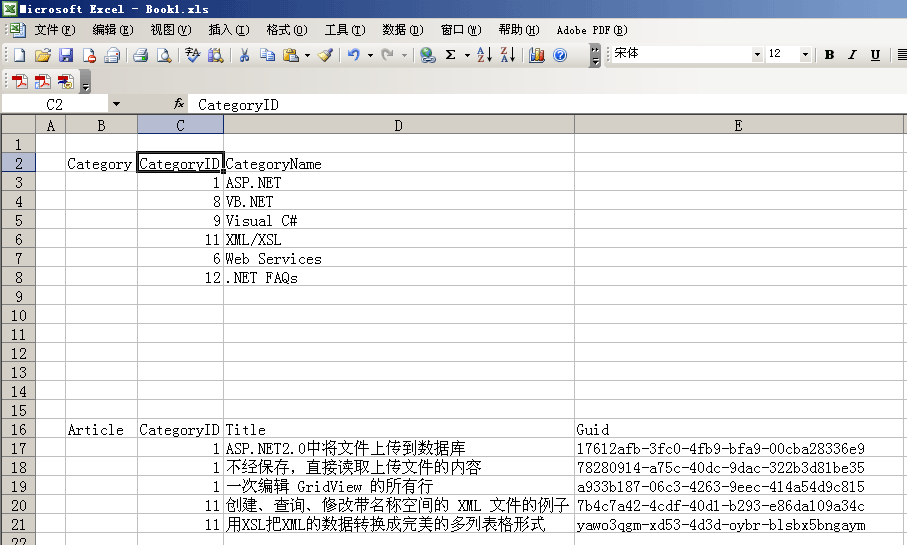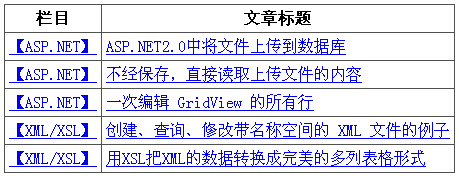LINQ是Visual Studio 2008及其以后版本中提供的功能,将强大的查询扩展到C#和VB.NET语言语法之中。LINQ提供了标准、简单的模式来查询和更新数据,同时还允许程序开发人员进行扩展,支持任何类型的数据存储。Visual Studio 2008包含了LINQ提供者程序集,能够对.NET Framework集合,内存中的对象数组,SQL Server数据库,ADO.NET Dataset和XML文档进行语言集成的查询。另外,我们也可以自己编写LINQ提供者,提供对任何类型数据的查询,只要实现了IEnumerable或者IEnumerable<T> (C#)或 IEnumerable (Of T) (Visual Basic)的数据类型,都可以进行使用LINQ进行操作。我们可以使用完全相同的语法查询SQL数据库、XML文档、ADO.NET的Dataset(DataTable)、内存中的集合对象,以及任何支持LINQ的远程或者本地数据源。在LINQ查询中,只与对象打交道,因此,可以完全不需要知道数据存储的数据源,而且采用的编程模型和语法也完全相同。
所有的LINQ查询基本上都是由3个基本的操作组成:得到数据源,创建查询和执行查询3个过程。数据的获得是在执行查询的时候完成的。在上一部分的例子(http://blog.csdn.net/net_lover/archive/2008/01/23/2060425.aspx)中,
是得到数据源
是创建查询,此时并没有对数据执行任何操作,
GridView2.DataBind();
在数据绑定时,才真正得到数据。
但是,有的查询需要立即执行,将结果放在内存中,可以调用查询或者查询变量的ToList<(Of <TSource>)> 或者 ToArray<(Of <TSource>)>方法。例如:
var query3 = query2.ToList();
好,既然说LINQ可以查询任何类型的数据,下面,咱们就试试如何查询一个Excel文件(说明:本程序在Excel 2003下今天测试的,在Excel2007中可能更简单,不过没有测试。运行本程序可能需要采用模拟或者调整Excel.exe的权限,另外注意:使用之前需要引用COM:Microsoft Office 11.0 Object Library
如果引用列表中没有,需要自行添加 C:\Program Files\Microsoft Office\OFFICE11\EXCEL.EXE)。
1,先准备一个Book1.xls,文件内容如下(将下面的XML文件在Excel里打开,另存为Book1.xls即可):

<? mso-application progid="Excel.Sheet" ?>
< Workbook xmlns ="urn:schemas-microsoft-com:office:spreadsheet"
xmlns:o ="urn:schemas-microsoft-com:office:office"
xmlns:x ="urn:schemas-microsoft-com:office:excel"
xmlns:ss ="urn:schemas-microsoft-com:office:spreadsheet"
xmlns:html ="http://www.w3.org/TR/REC-html40" >
< DocumentProperties xmlns ="urn:schemas-microsoft-com:office:office" >
< Author > zhy </ Author >
< LastAuthor > zhy </ LastAuthor >
< Created > 2008-01-25T13:13:34Z </ Created >
< LastSaved > 2008-01-26T13:10:56Z </ LastSaved >
< Version > 11.9999 </ Version >
</ DocumentProperties >
< ExcelWorkbook xmlns ="urn:schemas-microsoft-com:office:excel" >
< WindowHeight > 13050 </ WindowHeight >
< WindowWidth > 16020 </ WindowWidth >
< WindowTopX > 0 </ WindowTopX >
< WindowTopY > 105 </ WindowTopY >
< ProtectStructure > False </ ProtectStructure >
< ProtectWindows > False </ ProtectWindows >
</ ExcelWorkbook >
< Styles >
< Style ss:ID ="Default" ss:Name ="Normal" >
< Alignment ss:Vertical ="Center" />
< Borders />
< Font ss:FontName ="宋体" x:CharSet ="134" ss:Size ="12" />
< Interior />
< NumberFormat />
< Protection />
</ Style >
</ Styles >
< Worksheet ss:Name ="Sheet1" >
< Table ss:ExpandedColumnCount ="5" ss:ExpandedRowCount ="21" x:FullColumns ="1"
x:FullRows ="1" ss:DefaultColumnWidth ="54" ss:DefaultRowHeight ="14.25" >
< Column ss:Index ="3" ss:AutoFitWidth ="0" ss:Width ="102" />
< Column ss:AutoFitWidth ="0" ss:Width ="263.25" />
< Column ss:AutoFitWidth ="0" ss:Width ="246.75" />
< Row ss:Index ="2" >
< Cell ss:Index ="2" >< Data ss:Type ="String" > Category </ Data ></ Cell >
< Cell >< Data ss:Type ="String" > CategoryID </ Data ></ Cell >
< Cell >< Data ss:Type ="String" > CategoryName </ Data ></ Cell >
</ Row >
< Row >
< Cell ss:Index ="3" >< Data ss:Type ="Number" > 1 </ Data ></ Cell >
< Cell >< Data ss:Type ="String" > ASP.NET </ Data ></ Cell >
</ Row >
< Row >
< Cell ss:Index ="3" >< Data ss:Type ="Number" > 8 </ Data ></ Cell >
< Cell >< Data ss:Type ="String" > VB.NET </ Data ></ Cell >
</ Row >
< Row >
< Cell ss:Index ="3" >< Data ss:Type ="Number" > 9 </ Data ></ Cell >
< Cell >< Data ss:Type ="String" > Visual C# </ Data ></ Cell >
</ Row >
< Row >
< Cell ss:Index ="3" >< Data ss:Type ="Number" > 11 </ Data ></ Cell >
< Cell >< Data ss:Type ="String" > XML/XSL </ Data ></ Cell >
</ Row >
< Row >
< Cell ss:Index ="3" >< Data ss:Type ="Number" > 6 </ Data ></ Cell >
< Cell >< Data ss:Type ="String" > Web Services </ Data ></ Cell >
</ Row >
< Row >
< Cell ss:Index ="3" >< Data ss:Type ="Number" > 12 </ Data ></ Cell >
< Cell >< Data ss:Type ="String" > .NET FAQs </ Data ></ Cell >
</ Row >
< Row ss:Index ="16" >
< Cell ss:Index ="2" >< Data ss:Type ="String" > Article </ Data ></ Cell >
< Cell >< Data ss:Type ="String" > CategoryID </ Data ></ Cell >
< Cell >< Data ss:Type ="String" > Title </ Data ></ Cell >
< Cell >< Data ss:Type ="String" > Guid </ Data ></ Cell >
</ Row >
< Row >
< Cell ss:Index ="3" >< Data ss:Type ="Number" > 1 </ Data ></ Cell >
< Cell >< Data ss:Type ="String" > ASP.NET2.0中将文件上传到数据库 </ Data ></ Cell >
< Cell >< Data ss:Type ="String" > 17612afb-3fc0-4fb9-bfa9-00cba28336e9 </ Data ></ Cell >
</ Row >
< Row >
< Cell ss:Index ="3" >< Data ss:Type ="Number" > 1 </ Data ></ Cell >
< Cell >< Data ss:Type ="String" > 不经保存,直接读取上传文件的内容 </ Data ></ Cell >
< Cell >< Data ss:Type ="String" > 78280914-a75c-40dc-9dac-322b3d81be35 </ Data ></ Cell >
</ Row >
< Row >
< Cell ss:Index ="3" >< Data ss:Type ="Number" > 1 </ Data ></ Cell >
< Cell >< Data ss:Type ="String" > 一次编辑 GridView 的所有行 </ Data ></ Cell >
< Cell >< Data ss:Type ="String" > a933b187-06c3-4263-9eec-414a54d9c815 </ Data ></ Cell >
</ Row >
< Row >
< Cell ss:Index ="3" >< Data ss:Type ="Number" > 11 </ Data ></ Cell >
< Cell >< Data ss:Type ="String" > 创建、查询、修改带名称空间的 XML 文件的例子 </ Data ></ Cell >
< Cell >< Data ss:Type ="String" > 7b4c7a42-4cdf-40d1-b293-e86da109a34c </ Data ></ Cell >
</ Row >
< Row >
< Cell ss:Index ="3" >< Data ss:Type ="Number" > 11 </ Data ></ Cell >
< Cell >< Data ss:Type ="String" > 用XSL把XML的数据转换成完美的多列表格形式 </ Data ></ Cell >
< Cell >< Data ss:Type ="String" > yawo3qgm-xd53-4d3d-oybr-blsbx5bngaym </ Data ></ Cell >
</ Row >
</ Table >
< WorksheetOptions xmlns ="urn:schemas-microsoft-com:office:excel" >
< Print >
< ValidPrinterInfo />
< PaperSizeIndex > 9 </ PaperSizeIndex >
< HorizontalResolution > 200 </ HorizontalResolution >
< VerticalResolution > 200 </ VerticalResolution >
</ Print >
< Selected />
< Panes >
< Pane >
< Number > 3 </ Number >
< ActiveRow > 6 </ ActiveRow >
< ActiveCol > 2 </ ActiveCol >
</ Pane >
</ Panes >
< ProtectObjects > False </ ProtectObjects >
< ProtectScenarios > False </ ProtectScenarios >
</ WorksheetOptions >
</ Worksheet >
< Worksheet ss:Name ="Sheet2" >
< Table ss:ExpandedColumnCount ="0" ss:ExpandedRowCount ="0" x:FullColumns ="1"
x:FullRows ="1" ss:DefaultColumnWidth ="54" ss:DefaultRowHeight ="14.25" />
< WorksheetOptions xmlns ="urn:schemas-microsoft-com:office:excel" >
< ProtectObjects > False </ ProtectObjects >
< ProtectScenarios > False </ ProtectScenarios >
</ WorksheetOptions >
</ Worksheet >
< Worksheet ss:Name ="Sheet3" >
< Table ss:ExpandedColumnCount ="0" ss:ExpandedRowCount ="0" x:FullColumns ="1"
x:FullRows ="1" ss:DefaultColumnWidth ="54" ss:DefaultRowHeight ="14.25" />
< WorksheetOptions xmlns ="urn:schemas-microsoft-com:office:excel" >
< ProtectObjects > False </ ProtectObjects >
< ProtectScenarios > False </ ProtectScenarios >
</ WorksheetOptions >
</ Worksheet >
</ Workbook >
2,创建aspx:
Inherits = " LinqExcel " %>
<! DOCTYPE html PUBLIC "-//W3C//DTD XHTML 1.0 Transitional//EN" "http://www.w3.org/TR/xhtml1/DTD/xhtml1-transitional.dtd" >
< html xmlns ="http://www.w3.org/1999/xhtml" >
< head runat ="server" >
< title > LINQ to Excel </ title >
</ head >
< body >
< form id ="form1" runat ="server" >
< div >
< asp:GridView ID ="GridView1" runat ="server" AutoGenerateColumns ="false" CellPadding ="4" >
< Columns >
< asp:HyperLinkField DataNavigateUrlFields ="CategoryID" Target ="_blank"
DataNavigateUrlFormatString ="http://dotnet.aspx.cc/ShowList.aspx?id={0}"
HeaderText ="栏目" DataTextField ="CategoryName" DataTextFormatString ="【{0}】" />
< asp:HyperLinkField DataNavigateUrlFields ="ArticleGuid" Target ="_blank"
DataNavigateUrlFormatString ="http://dotnet.aspx.cc/article/{0}/read.aspx"
HeaderText ="文章标题" DataTextField ="ArticleTitle" />
</ Columns >
</ asp:GridView >
</ div >
</ form >
</ body >
</ html >
3,编写代码文件:
using System.Collections;
using System.Configuration;
using System.Data;
using System.Linq;
using System.Web;
using System.Web.Security;
using System.Web.UI;
using System.Web.UI.HtmlControls;
using System.Web.UI.WebControls;
using System.Web.UI.WebControls.WebParts;
using System.Xml.Linq;
using System.Collections.Generic;
using Microsoft.Office.Interop.Excel;
public partial class LinqExcel : System.Web.UI.Page
{
protected void Page_Load( object sender, EventArgs e)
{
string f = Server.MapPath( " ~/App_Data/Book1.xls " );
Open(f);
}
public void Open( string FilePath)
{
m_objExcel = new Application();
m_objExcel.Visible = false ;
m_objExcel.DisplayAlerts = false ;
if (m_objExcel.Version != " 11.0 " )
{
Response.Write( " 您的 Excel 版本不是 11.0 (Office 2003),操作可能会出现问题。 " );
m_objExcel.Quit();
return ;
}
m_objBooks = (Workbooks)m_objExcel.Workbooks;
m_objBook = m_objBooks.Open(FilePath, m_objOpt, m_objOpt, m_objOpt, m_objOpt, m_objOpt, m_objOpt, m_objOpt, m_objOpt, m_objOpt, m_objOpt, m_objOpt, m_objOpt, m_objOpt, m_objOpt);
m_objSheets = (Sheets)m_objBook.Worksheets;
m_objSheet = (_Worksheet)(m_objSheets.get_Item( 1 ));
List < Category > categorylist = LoadCategory();
List < Article > articlelist = LoadArticle();
var query = from art in articlelist
join cat in categorylist on art.CategoryID equals cat.CategoryID
select new { art.ArticleTitle, art.CategoryID, art.ArticleGuid, cat.CategoryName };
GridView1.DataSource = query;
GridView1.DataBind();
this .Close();
this .Dispose2();
}
private void Close()
{
m_objBook.Close( false , m_objOpt, m_objOpt);
m_objExcel.Quit();
}
public void Dispose2()
{
ReleaseObj(m_objSheets);
ReleaseObj(m_objBook);
ReleaseObj(m_objBooks);
ReleaseObj(m_objExcel);
System.GC.Collect();
System.GC.WaitForPendingFinalizers();
}
private void ReleaseObj( object o)
{
try
{
System.Runtime.InteropServices.Marshal.ReleaseComObject(o);
}
catch { }
finally { o = null ; }
}
private List < Category > LoadCategory()
{
List < Category > lc = new List < Category > ();
Category c;
m_objRange = m_objSheet.get_Range( " C2 " , " D8 " );
for ( int i = 1 ; i < m_objRange.Rows.Count; i ++ )
{
c = new Category();
Range r = (Range)m_objRange.Cells[i + 1 , 1 ];
c.CategoryID = Convert.ToInt32(r.Value2);
r = (Range)m_objRange.Cells[i + 1 , 2 ];
c.CategoryName = Convert.ToString(r.Value2);
lc.Add(c);
}
return lc;
}
private List < Article > LoadArticle()
{
List < Article > al = new List < Article > ();
Article a;
m_objRange = m_objSheet.get_Range( " C16 " , " E21 " );
for ( int i = 1 ; i < m_objRange.Rows.Count; i ++ )
{
a = new Article();
Range r = (Range)m_objRange.Cells[i + 1 , 1 ];
a.CategoryID = Convert.ToInt32(r.Value2);
r = (Range)m_objRange.Cells[i + 1 , 2 ];
a.ArticleTitle = Convert.ToString(r.Value2);
r = (Range)m_objRange.Cells[i + 1 , 3 ];
a.ArticleGuid = Convert.ToString(r.Value2);
al.Add(a);
}
return al;
}
private Application m_objExcel = null ;
private Workbooks m_objBooks = null ;
private _Workbook m_objBook = null ;
private Sheets m_objSheets = null ;
private _Worksheet m_objSheet = null ;
private Range m_objRange = null ;
private object m_objOpt = System.Reflection.Missing.Value;
}
public class Category
{
public Int32 CategoryID;
public string CategoryName;
}
public class Article
{
public Int32 CategoryID;
public string ArticleTitle;
public string ArticleGuid;
}
上面的代码将Excel中的两个区域分别放到了两个对象里面,利用对象进行LINQ查询。当然,这里的例子只是说明技术,在实际的应用中需要进行进一步的封装,也可能换别的方法。
4,运行结果:

由于LINQ可以自己定义提供者,因此,我们可以定义自己的数据源提供者。下面是网上写的一个LINQ to Excel Provider (作者是:http://solidcoding.blogspot.com/2007/12/linq-to-excel-provider.html)。其代码和使用方法如下:
LinqExcelProvider.cs:
using System.Collections.Generic;
using System.Linq;
using System.Text;
using System.Data.OleDb;
/// <summary>
/// Summary description for LinqExcelProvider
/// </summary>
public class ExcelRow
{
List < object > columns;
public ExcelRow()
{
columns = new List < object > ();
}
internal void AddColumn( object value)
{
columns.Add(value);
}
public object this [ int index]
{
get { return columns[index]; }
}
public string GetString( int index)
{
if (columns[index] is DBNull)
{
return null ;
}
return columns[index].ToString();
}
public int Count
{
get { return this .columns.Count; }
}
}
public class ExcelProvider : IEnumerable < ExcelRow >
{
private string sheet;
private string filePath;
private List < ExcelRow > rows;
public ExcelProvider()
{
rows = new List < ExcelRow > ();
}
public static ExcelProvider Create( string filePath, string sheet)
{
ExcelProvider provider = new ExcelProvider();
provider.sheet = sheet;
provider.filePath = filePath;
return provider;
}
private void Load()
{
string connectionString = @" Provider=Microsoft.Jet.OLEDB.4.0;Data Source={0};Extended Properties=""Excel 8.0;HDR=YES;"" " ;
connectionString = string .Format(connectionString, filePath);
rows.Clear();
using (OleDbConnection conn = new OleDbConnection(connectionString))
{
conn.Open();
using (OleDbCommand cmd = conn.CreateCommand())
{
cmd.CommandText = " select * from [ " + sheet + " $] " ;
using (OleDbDataReader reader = cmd.ExecuteReader())
{
while (reader.Read())
{
ExcelRow newRow = new ExcelRow();
for ( int count = 0 ; count < reader.FieldCount; count ++ )
{
newRow.AddColumn(reader[count]);
}
rows.Add(newRow);
}
}
}
}
}
public IEnumerator < ExcelRow > GetEnumerator()
{
Load();
return rows.GetEnumerator();
}
System.Collections.IEnumerator System.Collections.IEnumerable.GetEnumerator()
{
Load();
return rows.GetEnumerator();
}
}
使用方法:
foreach (ExcelRow row in (from x in provider select x))
{
Response.Write( " <li> " + row.GetString( 0 ) + " " + row.GetString( 1 ));
}
这样,查询数据就很方便了。





















 825
825

 被折叠的 条评论
为什么被折叠?
被折叠的 条评论
为什么被折叠?








